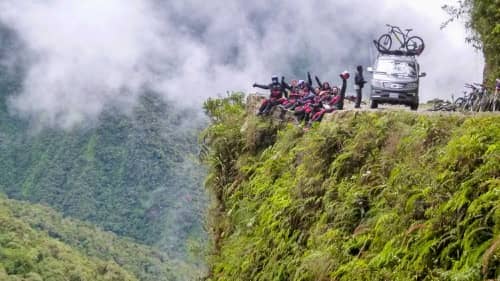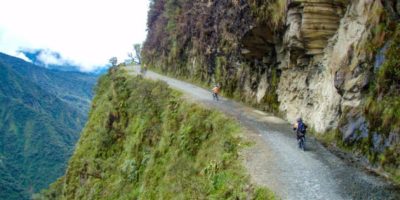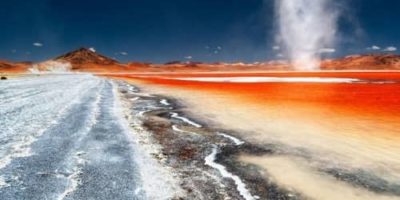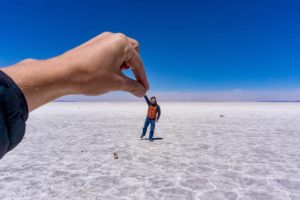If you like speed and adrenaline, you’ve definitely heard of cycling down the Death Road in Bolivia. Also called Camino de la Muerte, the Death Road was named as the most dangerous route in the world by the Inter-American Development Bank. And I’m going to tell you how you can go down this road on a mountain bike!
While the description of this road may sound scary, riding the Death Road by bike is an unforgettable and safe experience. After having cycled its 62 km, I can assure you that it’s an incredible experience if you love adventure sports and adrenaline!
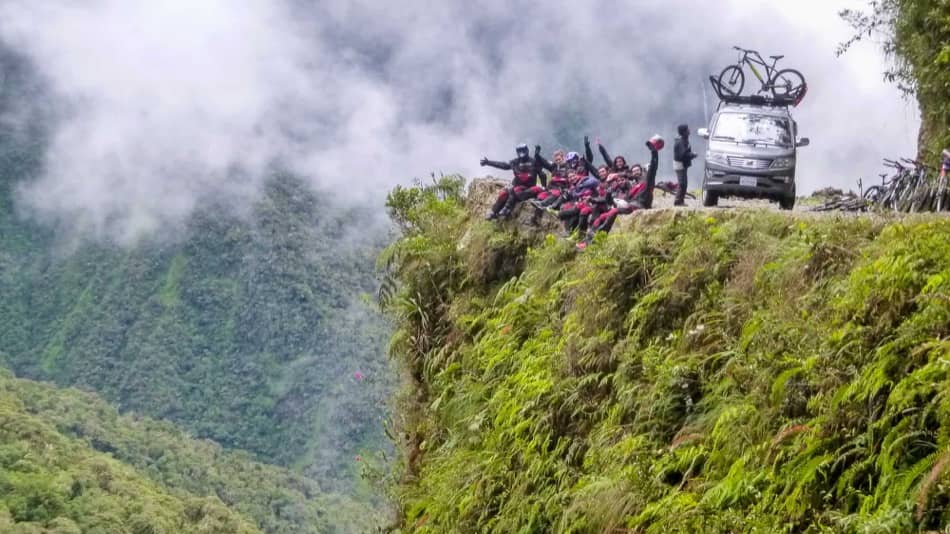
Contents
What is the Death Road?
Just 17km from the city of La Paz, there is a site called “La Cumbre” at an altitude of 4,657 meters above sea level. From this point, the “Death Road” descends to the area of Los Yungas (63km) where there is a small town called Yolosa whose altitude is 1,229 meters above sea level. There is a difference in altitude of 3,428 meters between La Cumbre and Yolosa.
The descent by bicycle begins in “La Cumbre”, at 4,657 meters above sea level and descends 32km on a paved road at speeds between 50 and 80km/h or more. Once the first 32km are completed, the route deviates to enter the “Camino de la Muerte” and descends another 31km to the town of Yolosa (1,229 meters above sea level).
In this second section the average speed is about 30 – 40km/h, due to the rocky and slippery road, but the panorama is more impressive due to the deep precipices, the dense vegetation and the drizzle. Your attention will have to be divided between avoiding stones, puddles, mud, etc. and admiring the landscape.
If you haven't booked your hotel yet, you can get the best deals on hotels here.
Where is the Death Road in Bolivia?
The Death Road (Yungas Road) is a narrow road of stones that connects the Bolivian Altiplano, La Paz, with the city of Coroico that’s located in the region of Yungas in the northern Amazon rainforest.
This deadly road was built in the 1930s by Paraguayan prisoners of war from the Chaco conflict. At that time, the Yungas Road was the only link between La Paz and the Yungas region. So, if you needed to make the trip, you would be risking your life on the road. In 2009, the Bolivian government opened a modern highway with two lanes, new pavement, drainage systems and guardrails that eliminated the need to travel on the Camino de la Muerte. That said, today, this road is used for cycling by thrill-seeking adventurers and adrenaline junkies like you and me.
How long and wide is the death road?
The Death Road is a 60 kilometers long, gravel road with sharp curves, giant cliffs and a width of less than 4 meters. This road is the extreme experience you were looking for. It goes without saying that you have to be VERY CAREFUL when cycling down this road.
How Dangerous is the Death Road?
A few years ago, the Death Road was so dangerous that it had an average of more than 200 accidents and 96 people killed per year. It was considered the most dangerous road in the world. Nowadays, there is a paved road that is much safer for vehicles, while the Death Road is mainly used for tourism in the form of downhill mountain biking.
How many people have died on Death Road in Bolivia?
During the 1990s, an average of 300 people a year died on the Death Road in Bolivia. In recent times, a new road was opened between La Paz and Coroico. The new stretch of road is used for vehicles going up, while the old “Death Road” is traveled by those going down. In recent times, there have been about 100 deaths per year on the Death Road.
The worst accident occurred during the 1980’s when a bus fell about 300 meters. More than 100 people died. Heavy trucks don’t leave much room for other road users. But the reputation of the road as dangerous predates the accidents of the last decades. In the 19th century, when goods were transported from La Paz to the city of Coroico, merchants already feared this stretch of road.
At that time, bandits used the narrow path to ambush merchants and steal their goods. Often, this resulted in fatalities.
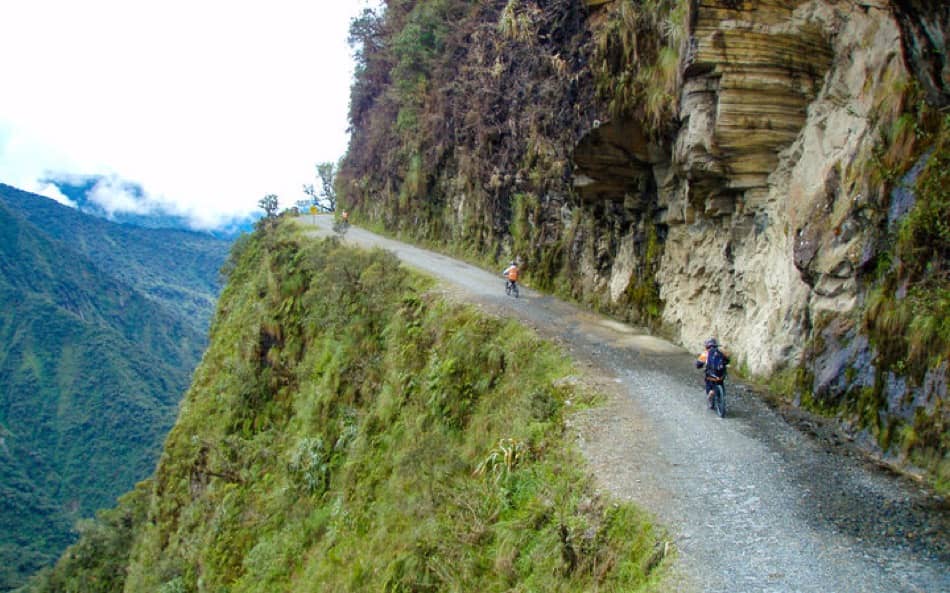
Getting to the Death Road from La Paz
The Death Road is approximately 2 hours from La Paz. Although you can do the trip yourself, I highly recommend using the services of a tour company. From La Paz, you can take all-inclusive tours, including equipment and meals. Each tour leaves in groups of 5 to 10 people. These groups are led by the tour guide and have a support car that always follows the last cyclist, in case of any eventuality.
Typical Itinerary
In general, cycling on the Death Road lasts for about 5 to 6 hours. It takes a few more hours to travel to and from La Paz. Here’s a brief overview of the itinerary.
The tours to the Death Road start in La Paz, from where you will go to the Cordillera Real. The descent begins at “La Cumbre”, the highest point on the road to Coroico (over 4300 meters above sea level). The first trip is about 22 kilometers (1 hour aprox.), through a paved road. Then there is an 8 km. climb that is done in the support vehicle that accompanies the caravan.
This is where the fun begins, because you get back on your bikes, to continue on the Death Road. In a 36 kms. stretch, you will go down through the narrow paths and meet monumental cliffs and waterfalls.
After four hours, you will finish the descent to Yolosa, a community near Coroico (1600 meters above sea level). Some of the tours offer additional services, such as lunch at the Senda Verde refuge.
If you’re still not comfortable and want more details, here you go:
You’ll start the day very early at the agency office in La Paz. Generally, the groups are small with 1 guide assigned to a maximum of 5 to 6 people. Shared transportation is included in your tour and you’ll get into a van which will take you the starting point of the tour. The starting point is called “La Cumbre” or “The Summit” at an elevation of 4700 meters.
Here, you get a short break and some breakfast. You also get some cocoa leaves here to help with the altitude sickness. After breakfast, you get an opportunity to try out the bikes and get comfortable with them.
The backup van always follows you in case you ever need to stop, rest or discontinue the trip at any time. The first section of the route runs along a paved road. This helps you gain confidence on the bike. In general, there’s not much traffic here and you ride downhill for approximately 20 kilometers.
After the first section, there’s no more asphalt and you arrive at the REAL Death Road. It’s 45 kilometers of stones, endless slopes, waterfalls, 900-meter cliffs, but above all, incredible landscapes of green mountains covered with thick vegetation that will leave you breathless.
There are several stops planned throughout the trip. You’ll stop to have a snack, to take pictures and videos in the most interesting spots, to take off your layers as the temperature rises and whenever you need to rest your aching. The road is all downhill and in some cases, the slopes are very steep. If you’re not comfortable on the bike, you’ll be riding the brakes constantly.
The last few kilometers are the most challenging. You eventually end up at the village of Yolosa, which is 1200 meters above sea level. Depending on the tour company you choose, you might get a chance to shower and grab a bite at the refuge.
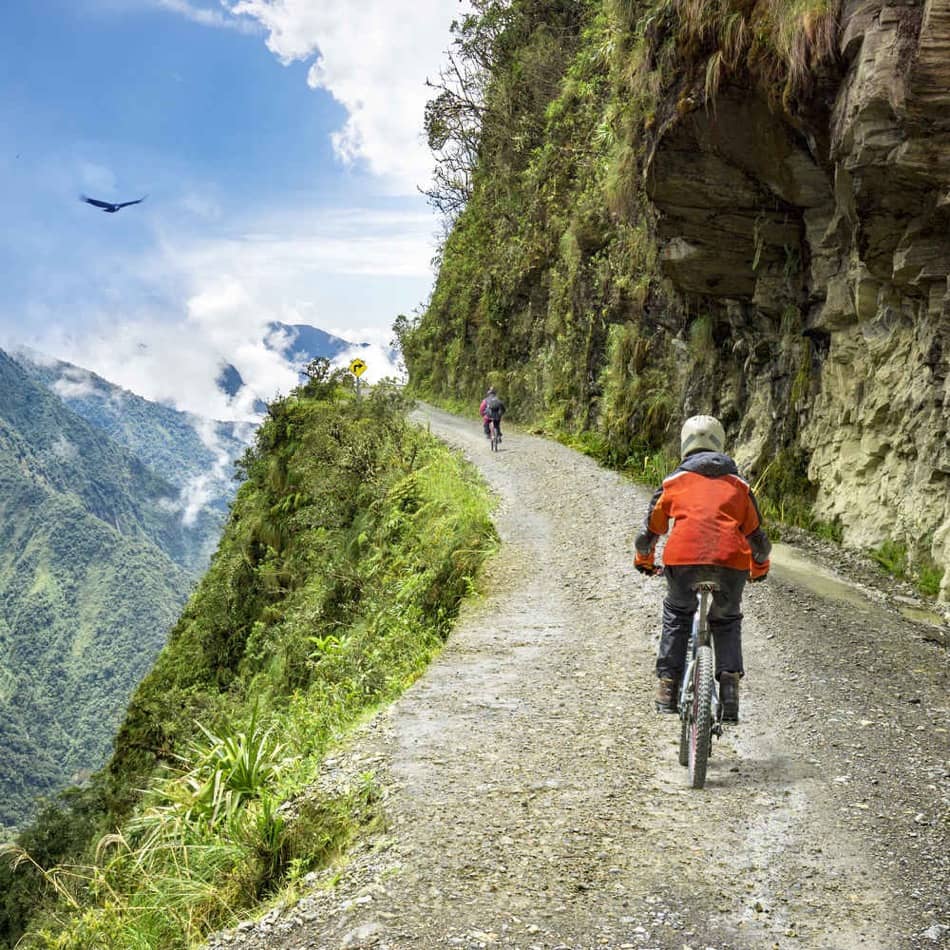
Choosing a Tour Company & How Much to Pay
The highest rated tour companies for the Death Road tour are:
Gravity Bolivia
Altitude Travel
Vertigo Biking
Barracuda Biking
Gravity Bolivia
Probably one of the safest companies to go with, Gravity Bolivia has been doing Death Road tours for over 20 years. Although they’re the most expensive operator, they are also the only company that meets international safety standards. All their bikes are under 3 years old and undergo daily maintenance checks. They also have the most experienced and knowledgeable guides in La Paz.
Altitude Travel
Altitude Travel is another reliable, safe company that you can use to book your Death Road trip. Currently (September 2020), they’re running a promo where you can book the trip for just $50. They use specialized mountain bikes with hydraulic brakes for all their tours.
Vertigo Biking
Vertigo Biking is another company with a lot of experience doing Death Road tours. They’ve been operating for 10 years and have an excellent safety record. Vertigo is a very ethical company that uses only original manufacturer parts and not cheap replacements. All their guides are also trained in First Aid and rescue.
Barracuda Biking
Barracuda Biking is another great company. They use only original Kona bikes for all their trips and the bikes go for a maintenance check after each trip. The best part is that a dip in a swimming pool at the end of the Death Road is included!
The Yolosa – La Cumbre Challege
In 2005, the group of cyclists “Los Huanca” from La Paz, invented a cycling challenge that consists of ascending from Yolosa to La Cumbre. That year approximately 20 amateur cyclists participated. Since then, the event “Yolosa – La Cumbre” has been held annually, each year with more participants (400 in 2019) and includes a category of professional cyclists. In fact, it is the most important cycling event in Bolivia that attracts cyclists from abroad.
The route can be divided into two sections:
First section of the route (Yolosa – Chuspipata)
This stretch, 31km on a dirt road, is the famous Camino de la Muerte. It has about 10km at 4.4% slope and 21km at 7.4% (up to the asphalt). The ascent takes about 4 hours for a novice cyclist. Although it is dirt road, due to the humidity of the area the terrain is well settled but you have to cross several streams and go under waterfalls.
Chuspipata is only a halfway point with a part-time record. Many cyclists take a 15-minute break here and take the opportunity to change clothes, eat, recharge and, of course, take the usual pictures. However, this can be done at any point along the route.
Second section of the route (Chuspipata – La Cumbre)
This 32km stretch is on a paved road with cars and buses , so it is essential to keep to the right. This section can be divided into two sectors: one of 10km with 1.7% slope and another of 22km with 6.3% average slope.
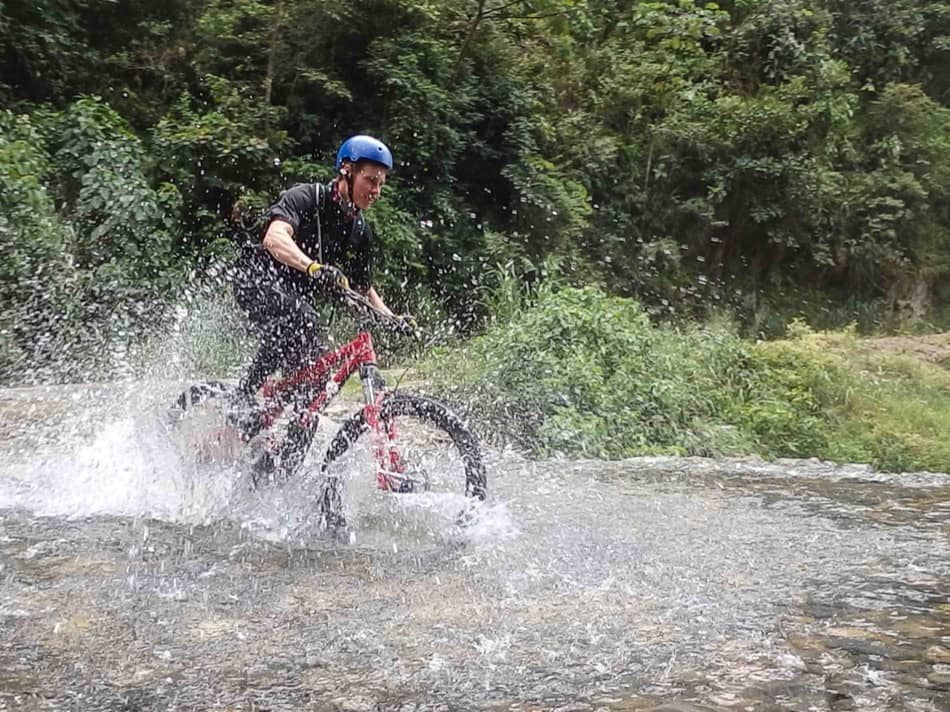
Zzip The Flying Fox – The Zipline on Death Road
Built in 2010, Zzipp The Flying Fox is a zipline built over the jungle. Get a birds eye view of the jungle on a canopy tour. Zzip the Flying Fox offers three lines in Yolosa that can be combined with Death Road for a complete adrenaline rush; the highest rises to 350 meters (1,148 feet) above the jungle floor, can reach speeds of up to 85 kilometers (53 miles) per hour in the fastest, and the most panoramic views of a wildlife reserve.
